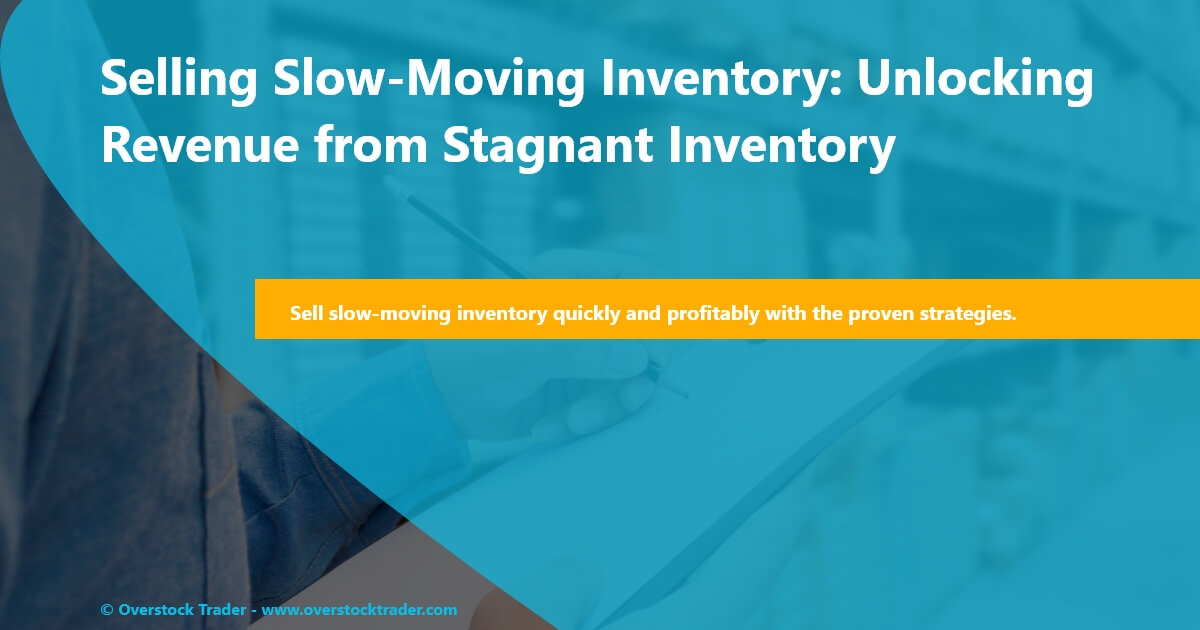Every business that sells inventory is bound to encounter the challenge of slow-moving inventory at some point. Slow-moving inventory, often referred to as dead stock, ties up valuable resources and can hurt your bottom line. However, with the right strategies in place, you can transform this stagnant stock into a source of revenue and free up much-needed storage space. In this article, we will explore effective strategies for selling slow-moving inventory.
Selling Slow-Moving Inventory and Generating Revenue
Slow-moving inventory can be a major drain on your business’s resources. It takes up valuable warehouse space, ties up cash, and can eventually become obsolete. However, there are several things you can do to sell surplus inventory and generate revenue. Let’s take a look into different approaches
Implement a Data-Driven Approach
The first step in addressing slow-moving inventory is to gain a deep understanding of your stock’s performance. Utilize your inventory management software to generate reports and identify which items are moving slowly. Analyze historical sales data to determine trends, seasonality, and demand patterns. Armed with this information, you can make informed decisions about how to address each item.
Reprice and Offer Discounts
One of the most straightforward ways to move slow inventory is by adjusting prices. Offer discounts or promotions to entice customers to purchase these items. You can create a sense of urgency by setting time-limited sales, bundling slow-moving items with faster-selling products, or offering buy-one-get-one deals. Ensure that your pricing strategy still allows you to cover costs and generate a profit, even if it’s reduced.
Leverage Cross-Promotion
Cross-promotion is an effective technique for drawing attention to slow-moving inventory. Showcase these items on your website’s homepage or in email newsletters, alongside your best-selling products. Use compelling visuals and persuasive copy to highlight the unique value of these items or any special features that make them worth considering.
Create Product Bundles

Consider bundling slow-moving items with complementary products that are selling well. This strategy not only helps move the excess inventory but also encourages customers to purchase more items. Bundles can be marketed as cost-effective options or as a way to save time and effort when shopping.
Explore Multiple Sales Channels
Don’t limit yourself to just one sales channel. If slow-moving inventory is a persistent issue, consider expanding to other platforms such as online marketplaces, social media marketplaces, or even physical pop-up stores. Different channels can expose your products to new audiences and increase the chances of finding buyers.
Implement a Clearance Section
Create a dedicated clearance or sale section on your website or in your physical store. Appealingly organize slow-moving inventory and mark down prices. This provides a space for bargain hunters and helps declutter your main product listings.
Consider Liquidating Slow-Moving Inventory
In some cases, it may be more cost-effective to liquidate slow-moving inventory, especially if the carrying costs are significant. Some of the more common costs are warehousing space, carrying costs on capital, and having your team move, update, and sell this stagnant inventory. As discussed in our previous article, you may also want to check the hidden cost of inventory impacts.
Monitor and Adjust Regularly
Inventory management is an ongoing process. Continuously monitor the performance of your slow-moving inventory and adjust your strategies accordingly. As market conditions change and customer preferences evolve, staying flexible and responsive is crucial.
Want to know the value of your inventory?
Conclusion
Slow-moving inventory doesn’t have to be a burden on your business. By employing these strategies and regularly evaluating their effectiveness, you can turn stagnant stock into a source of revenue and make your inventory management more efficient. Remember that every product has its audience, and with the right approach, even the slowest-moving items can find their way into the hands of satisfied customers.
If you’ve tried all the strategies above and your slow-moving inventory is still draining your resources, Overstock Trader’s inventory liquidation service could be a great option. Overstock Trader is a leading inventory liquidation company that can help you sell your excess inventory quickly and efficiently. We have a vast network of excess inventory buyers and can reach a wide audience of potential customers.
No matter what your needs are, we can develop a customized inventory liquidation solution that is right for you. Contact us today to learn more about our services and how we can help you get rid of your slow-moving inventory.
Frequently Asked Questions
What is slow-moving inventory, and why is it a concern for businesses?
Slow-moving inventory refers to products that are taking longer than expected to sell, tying up capital and storage space. It can be a concern for businesses as it affects cash flow and profitability. Identifying and addressing slow-moving inventory is essential to optimize inventory turnover.
What are effective ways to deal with slow-moving inventory?
There are several strategies to address slow-moving inventory. These include bundling slow-moving products with faster-selling items, implementing marketing strategies and promotions, and using inventory management software to identify and manage slow-moving stock.
How can businesses turn slow-moving inventory into cash flow?
To convert slow-moving inventory into cash, businesses can consider selling excess stock through promotions, using effective marketing strategies to boost sales, and optimizing inventory management. By preventing slow-moving inventory and managing it efficiently, businesses can improve cash flow.
What causes slow-moving inventory, and how can it be prevented?
Slow-moving inventory can result from various factors, including changes in customer demand and seasonality. To prevent it, businesses should regularly review inventory turnover rates, adjust pricing, bundle products, and build an email list for promotions.
What are the benefits of addressing slow-moving inventory for businesses?
Addressing slow-moving inventory offers several benefits, including improved cash flow, reduced inventory holding costs, and the opportunity to maximize the value of the inventory. It also helps businesses free up space in their warehouse and create new landing pages to help sell slow-moving items more effectively.

